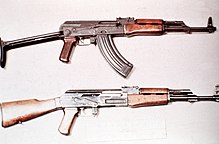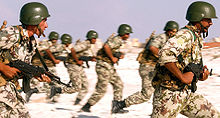AKM: Difference between revisions
→Users: Added citations and removed uncited from December 2009 |
→Users: Additional information |
||
| Line 109: | Line 109: | ||
[[Image:Romanian AKM Soldier.JPEG|thumb|right|A Romanian [[sub-officer]] with a PM md. 65]] |
[[Image:Romanian AKM Soldier.JPEG|thumb|right|A Romanian [[sub-officer]] with a PM md. 65]] |
||
| ⚫ | |||
| ⚫ | *{{flag|Egypt}}: The '''Misr''' is an |
||
*{{flag|Algeria}}<ref name="jones2009"/> |
|||
*{{flag|Angola}}<ref name="jones2009"/> |
|||
*{{flag|Armenia}}<ref name="jones2009"/> |
|||
*{{flag|Azerbaijan}}<ref name="jones2009"/> |
|||
*{{flag|Bangladesh}}<ref name="jones2009"/> |
|||
*{{flag|Belarus}}<ref name="jones2009"/> |
|||
*{{flag|Benin}}<ref name="jones2009"/> |
|||
*{{flag|Bosnia-Herzegovina}}<ref name="jones2009"/> |
|||
*{{flag|Botswana}}<ref name="jones2009"/> |
|||
*{{flag|Bulgaria}}<ref name="jones2009"/> |
|||
*{{flag|Cambodia}}<ref name="jones2009"/> |
|||
*{{flag|Cape Verde}}<ref name="jones2009"/> |
|||
*{{flag|Central African Republic}}<ref name="jones2009"/> |
|||
*{{flag|Chad}}<ref name="jones2009"/> |
|||
*{{flag|Comoros}}<ref name="jones2009"/> |
|||
*{{flag|Congo}}<ref name="jones2009"/> |
|||
*{{flag|Congo-Brazzaville}}<ref name="jones2009"/> |
|||
*{{flag|Cuba}}<ref name="jones2009"/> |
|||
| ⚫ | *{{flag|Egypt}}: The '''Misr''' is an Egyptian copy of the AKM, manufactured by Factory 54 of the Maadi Company for Engineering Industries in [[Cairo]] for the [[Egyptian Army]] and for export sales.<ref>{{cite web|url=http://www.fas.org/nuke/guide/egypt/facility/maadi-54.htm |title=Maadi Company for Engineering Industries (Factory 54) Special Weapons Facilities - Egypt |publisher=Fas.org |date= |accessdate=2009-11-20}}</ref><ref>{{cite web|author=John Pike |url=http://www.globalsecurity.org/military/world/egypt/maadi-54.htm |title=Maadi Company for Engineering Industries (Factory 54) |publisher=Globalsecurity.org |date=2005-04-27 |accessdate=2009-11-20}}</ref><ref>{{cite web|url=http://www.avtomats-in-action.com/pro16.html |title=Exhibits Page 16 |publisher=Avtomats-in-action.com |date= |accessdate=2009-11-20}}</ref><ref>{{cite web|author=Jeff Freeman |url=http://home.comcast.net/~jfreeman16/page_4.htm |title=Egyptian Rifles |publisher=Home.comcast.net |date= |accessdate=2009-11-20}}</ref><ref>[http://www.smallarmssurvey.org/files/portal/issueareas/producer/Producers_pdf/2007_Production.pdf ]{{dead link|date=November 2009}}</ref> |
||
*{{flag|Equatorial Guinea}}<ref name="jones2009"/> |
|||
*{{flag|Eritrea}}<ref name="jones2009"/> |
|||
*{{flag|Estonia}}<ref name="jones2009"/> |
|||
*{{flag|Finland}}: Holds stocks of imported AKM clones for wartime reserve service (the Chinese Type 56 known as the '''RK 56 TP'''<ref>{{cite web|url=http://www.mil.fi/maavoimat/kalustoesittely/index.dsp?level=63&equipment=40 |title=Puolustusvoimat: Kalustoesittely |publisher=Mil.fi |date=2009-05-20 |accessdate=2009-11-20}}</ref> and the East German MPi-KM as the '''RK 72'''<ref>{{cite web|url=http://www.mil.fi/maavoimat/kalustoesittely/index.dsp?level=63&equipment=39 |title=Puolustusvoimat: Kalustoesittely |publisher=Mil.fi |date=2009-05-20 |accessdate=2009-11-20}}</ref>) along with locally designed AK derivatives (the '''[[RK 62]]''' and the '''[[RK 95 TP]]'''). |
*{{flag|Finland}}: Holds stocks of imported AKM clones for wartime reserve service (the Chinese Type 56 known as the '''RK 56 TP'''<ref>{{cite web|url=http://www.mil.fi/maavoimat/kalustoesittely/index.dsp?level=63&equipment=40 |title=Puolustusvoimat: Kalustoesittely |publisher=Mil.fi |date=2009-05-20 |accessdate=2009-11-20}}</ref> and the East German MPi-KM as the '''RK 72'''<ref>{{cite web|url=http://www.mil.fi/maavoimat/kalustoesittely/index.dsp?level=63&equipment=39 |title=Puolustusvoimat: Kalustoesittely |publisher=Mil.fi |date=2009-05-20 |accessdate=2009-11-20}}</ref>) along with locally designed AK derivatives (the '''[[RK 62]]''' and the '''[[RK 95 TP]]'''). |
||
*{{flag|Gabon}}<ref name="jones2009"/> |
|||
| ⚫ | |||
*{{flag|Georgia}}<ref name="jones2009"/> |
|||
*{{flag|Guinea}}<ref name="jones2009"/> |
|||
*{{flag|Guinea-Bissau}}<ref name="jones2009"/> |
*{{flag|Guinea-Bissau}}<ref name="jones2009"/> |
||
*{{flag|Guyana}}<ref name="jones2009"/> |
*{{flag|Guyana}}<ref name="jones2009"/> |
||
| Line 117: | Line 141: | ||
*{{flag|India}}<ref name="jones2009"/> |
*{{flag|India}}<ref name="jones2009"/> |
||
*{{flag|Iran}}<ref name="jones2009"/> |
*{{flag|Iran}}<ref name="jones2009"/> |
||
*{{flag|Iraq}}<ref name="jones2009"/> |
|||
*{{flag|Israel}}<ref name="jones2009"/> |
*{{flag|Israel}}<ref name="jones2009"/> |
||
*{{flag|Kazakhstan}}<ref name="jones2009"/> |
*{{flag|Kazakhstan}}<ref name="jones2009"/> |
||
| Line 132: | Line 157: | ||
*{{flag|Mozambique}}<ref name="jones2009"/> |
*{{flag|Mozambique}}<ref name="jones2009"/> |
||
*{{flag|North Korea}}: Type 68 variant.<ref name="jones2009"/> |
*{{flag|North Korea}}: Type 68 variant.<ref name="jones2009"/> |
||
*{{flag|Pakistan}}: Type 56 variant.<ref name="jones2009"/> |
|||
*{{flag|Peru}}<ref name="jones2009"/> |
|||
*{{flag|Qatar}}<ref name="jones2009"/> |
|||
*{{flag|Republic of Macedonia}}<ref name="jones2009"/> |
*{{flag|Republic of Macedonia}}<ref name="jones2009"/> |
||
*{{flag|Romania}}<ref name="jones2009"/> |
|||
*{{flag|Somalia}}<ref>http://www.defenseimagery.mil/imagery.html#guid=0c8964e404e8c3347c7364a5e490233b6a8c62e4</ref> |
|||
*{{flag|Russia}}<ref name="jones2009"/> |
|||
*{{flag|Sao Tome and Principe}}<ref name="jones2009"/> |
|||
*{{flag|Seychelles}}<ref name="jones2009"/> |
|||
*{{flag|Sierra Leone}}<ref name="jones2009"/> |
|||
*{{flag|Slovenia}}<ref name="jones2009"/> |
|||
*{{flag|Somalia}}<ref name="jones2009"/> |
|||
*{{flag|Sudan}}<ref name="jones2009"/> |
|||
*{{flag|Suriname}}<ref name="jones2009"/> |
|||
*{{flag|Syria}}<ref name="jones2009"/> |
|||
*{{flag|Tajikistan}}<ref name="jones2009"/> |
|||
*{{flag|Tanzania}}<ref name="jones2009"/> |
|||
*{{flag|Togo}}<ref name="jones2009"/> |
|||
*{{flag|Turkey}}<ref name="jones2009"/> |
|||
*{{flag|Turkmenistan}}<ref name="jones2009"/> |
|||
*{{flag|Ukraine}}<ref name="jones2009"/> |
|||
*{{flag|United Arab Emirates}}<ref name="jones2009"/> |
|||
*{{flag|Uzbekistan}}<ref name="jones2009"/> |
|||
*{{flag|Vietnam}}<ref name="jones2009"/> |
|||
*{{flag|Yemen}}<ref name="jones2009"/> |
|||
*{{flag|Yugoslavia}}: Several variants based on the AKM built by [[Zastava Arms]] factory, most notably the '''[[Zastava M70|M70]]''' and '''[[Zastava M70B|M70B]]'''.<ref>{{cite web|url=http://www.zastava-arms.co.rs/images/vojni/7_62/762_engleski.htm |title=consists of: |publisher=Zastava-arms.co.rs |date= |accessdate=2009-11-20}}</ref> |
*{{flag|Yugoslavia}}: Several variants based on the AKM built by [[Zastava Arms]] factory, most notably the '''[[Zastava M70|M70]]''' and '''[[Zastava M70B|M70B]]'''.<ref>{{cite web|url=http://www.zastava-arms.co.rs/images/vojni/7_62/762_engleski.htm |title=consists of: |publisher=Zastava-arms.co.rs |date= |accessdate=2009-11-20}}</ref> |
||
*{{flag|Zambia}}<ref name="jones2009"/> |
|||
*{{flag|Zimbabwe}}<ref name="jones2009"/> |
|||
==References== |
==References== |
||
Revision as of 01:45, 2 March 2010
| AKM | |
|---|---|
 The AKM rifle | |
| Type | Assault rifle |
| Place of origin | |
| Service history | |
| In service | 1961–present |
| Used by | See Users |
| Wars | Vietnam War, Cambodian Civil War, Cambodian-Vietnamese War, Soviet war in Afghanistan, Iran–Iraq War, First Chechen War, Iraq War, War in Afghanistan (2001-present) |
| Production history | |
| Designer | Mikhail Kalashnikov |
| Designed | 1950s |
| No. built | 10,278,300[1] |
| Variants | AKMS, AKMP, AKML, AKMLP, AKMSP, AKMSN, AKMSNP |
| Specifications | |
| Mass | Template:Kg to lb (AKM) 3.80 kg (8.4 lb) (AKML) 3.3 kg (7.3 lb) (AKMS) 3.77 kg (8.3 lb) (AKMSN) |
| Length | Template:Mm to in (AKM, AKML) 902 mm (35.5 in) stock extended / 655 mm (25.8 in) stock folded (AKMS, AKMSN) |
| Barrel length | 415 mm (16.3 in) |
| Cartridge | 7.62x39mm |
| Action | Gas operated, rotating bolt |
| Rate of fire | 600 rounds/min |
| Muzzle velocity | 715 m/s (2,346 ft/s) |
| Effective firing range | 100–1,000 m sight adjustments |
| Feed system | 20 or 30-round detachable box magazine, also compatible with 40-round box or 75-round drum magazines from the RPK |
| Sights | Rear sight notch on sliding tangent, front post 378 mm (14.9 in) sight radius |
The AKM (Russian: Автомат Калашникова Модернизированный; Avtomat Kalashnikova Modernizirovanniy or "automatic rifle Kalashnikov modernized") is a 7.62mm assault rifle designed by Mikhail Kalashnikov. It is an upgraded version of the AK-47 rifle and was developed in the 1950s. Introduced into service with the Red Army in 1959, the AKM is the most ubiquitous variant of the entire AK series of firearms and it has found widespread use with most member states of the former Warsaw Pact and its many African and Asian allies. The production of Soviet rifles was carried out at both the Tula Arsenal and Izhevsk Mechanical Works. It was officially replaced in Soviet service by the AK-74 in the late 70s, but remains in use worldwide.
Design details
The AKM is an assault rifle using the 7.62x39mm Soviet intermediate cartridge. It is gas operated with a rotating bolt. The AKM is capable of selective fire, firing either single shots or automatic at a cyclic rate of 600 rounds/min.
Features

Compared to the AK-47, the AKM features detail improvements and enhancements that optimized the rifle for mass production; some parts and assemblies were conceived using simplified manufacturing methods. Notably, the AK-47's milled steel receiver was replaced by a U-shaped steel stamping. As a result of these modifications, the AKM’s weight was reduced by approx. 1 kg, the accuracy during automatic fire was increased and several reliability issues were addressed. The AK-47's chrome-lined barrel was retained, a common feature of Soviet weapons which resists corrosion that would otherwise result from the corrosive-primed ammunition and sporadic cleaning practices.
The AKM’s receiver, compared to the AK-47, has a stamped sheet metal housing to which a rear stock trunnion and forward barrel trunnion are fastened using rivets. The receiver housing also features a rigid tubular cross-section support that adds structural strength. Guide rails that assist the bolt carrier’s movement which also incorporates the ejector are installed inside the receiver through spot welding.
The forward barrel trunnion has a non-threaded socket for the barrel and a transverse hole for a pin that secures the barrel in place. On some models the rear trunnion has two extended mounting arms on both sides that support the buttstock, other fixed models use a stepped shaped trunnion that covers the full width of the inside of the receiver.
As a weight-saving measure, the stamped dust cover is of thinner gauge metal than that of the AK-47. In order to maintain strength and durability it employs both longitudinal and latitudinal reinforcing ribs.
The AKM’s barrel is installed in the forward trunnion and pinned (as opposed to the AK-47, which has a one piece receiver with integral trunnions and a barrel that is screwed-in). Additionally the barrel has horizontal guide slots that help align and secure the handguards in place. To increase the weapon’s accuracy during automatic fire, the AKM was fitted with a slant cut muzzle brake that helps redirect expanding propellant gases upward and to the right during firing, which mitigates the rise of the muzzle during an automatic burst when held by a right-handed firer. The muzzle brake is threaded on to the end of the barrel with a left-hand thread. The AKM's slant brake can also be used on the AK-47, which had a simple nut to cover the threads.

The gas block in the AKM does not have a cleaning rod capture or sling loop but is instead fitted with an integrated bayonet support collar that has a cleaning rod guide hole. The forward sling loop was relocated to the front handguard retainer cap. The handguard retainer also has notches that determine the position of the handguards on the barrel. The AKM’s laminated wood handguards have lateral grooves that help securely grip the rifle.
Gas relief ports that alleviate gas pressure in the piston cylinder (placed horizontally in a row on the gas cylinder in the AK-47) were moved forward to the gas block and placed in a radial arrangement.
The AKM’s bolt carrier is slightly lighter in weight and despite some minor differences in its shape – it can be used interchangeably with the AK-47’s bolt carrier and bolt.
The wooden stock used in the AKM is further hollowed in order to reduce weight and is longer and more straight than that of the AK-47, which assists accuracy for subsequent shots during rapid and automatic fire.
The AKM uses a modified return spring mechanism, which replaces the single recoil spring guide rod with a dual “U”-shaped wire guide.
The AKM has a modified trigger assembly, equipped with a hammer-release delaying device (installed on the same axis pin together with the trigger and disconnector) commonly called a "rate reducer". In fact its primary purpose is not to reduce the rate of automatic fire; it is a safety device to ensure the weapon will only fire on automatic when the bolt is fully locked, as the hammer is tripped by the bolt carrier's last few millimetres of forward movement. The device also reduces "trigger slap" or "trigger bounce" and the weapon’s rate of fire, which also reduces the dispersion of bullets when firing in fully-automatic mode. The hammer was also changed and equipped with a protrusion that engages the rate reducer and the trigger has only one notched hammer release arm (compared to two parallel arms in the AK-47).
The AKM’s rear sight consists of a ramp with a range scale marked from 100 to 1,000 m (graduated every 100 m), as compared to that of the original AK-47, which was graduated to 800 meters. The rear sight leaf’s position teeth that secure the sliding adjustable notch were transferred over from the right to the left edge of the ramp. The front sight post also has a slightly different shape and its bottom portion is more narrow.
The weapon uses the same ammunition as the AK-47: the 7.62x39mm M43 intermediate rifle cartridge. The AKM mechanism's design principles and procedures for loading and firing are practically identical to those of the AK-47, the only difference being the trigger assembly (during the return stage of the bolt carrier on fully automatic mode) as a result of incorporating the rate reducer device.
Accessories
The AKM comes supplied with a different accessory kit that contains a M1959 6H4 or 6H3-type bayonet (that forms a wire-cutting device when coupled with its scabbard) and comes with synthetic or alloy magazines. The kit also comes with a punch used to drive out various pins and a device that aids in assembling the rate retarding mechanism.
Variants
AKMS

The main variant of the AKM is the AKMS (S – Skladnoy [Folding]), which was equipped with an under-folding metal shoulder stock in place of the fixed wooden stock. The metal stock of the AKMS is somewhat different from the folding stock of the previous AKS-47 model as it has a modified locking mechanism, which locks both support arms of the AKMS stock instead of just one (left arm) as in the AKS-47 folding model. It is also made of rivetted steel pressings, instead of the milled versions of most AKS-47s.
The AKM was produced in the following versions: AKMP, AKML and AKMLP, whereas the AKMS led to the following models – AKMSP, AKMSN and AKMSNP.
The AKMP rifle uses subdued tritium-illuminated aiming points integrated into the front and rear sight. These sights enable targets to be engaged in low-level light conditions, i.e. when the battlefield is illuminated with flares, fires or muzzle flashes or when the target is visible as a shadow against an illuminated background. The sliding notch on the sight arm is then moved to the “S” setting (which corresponds to the “3” setting in the AKM). The sight itself is guided on the sliding scale and has a socket, which contains a tritium gas-filled capsule directly beneath the day-time notch. The tritium front post installs into the front sight base using a detent and spring.

The AKML comes equipped with a side-rail used to attach a night vision device. The mount comprises a flat plate riveted to the left wall of the receiver housing and a support bracket fixed to the mounting base with screws. To shield the light-sensitive photo detector plate of the night vision sight, the weapon uses a slotted flash suppressor, which replaces the standard recoil compensator. The AKML can also be deployed in the prone position with a detachable barrel-mounted bipod that helps stabilize the weapon and reduces operator fatigue during prolonged periods of observation. The bipod is supplied as an accessory and is carried in a holster attached to the duty belt.
The AKMLP is a version of the AKML with tritium sights (as in the AKMP).
The AKMSP rifle is based on the folding stock AKMS variant but fitted with tritium night sights, as in the AKMP.
The AKMSN model is derived from the AKMS and features an accessory rail used to mount a night vision sensor as seen on the AKML and additionally a flash hider and bipod. The left arm of the AKMSN’s folding stock is bent outwards in order to avoid the sight mount bracket during folding and the sling loop was moved further to the rear.
A version of the AKMSN additionally supplied with factory tritium night sights is called the AKMSNP.
A version of the AKM with a modified lower handguard designed to accept the 40 mm wz. 1974 Pallad grenade launcher was developed in Poland and designated the karabinek-granatnik wz. 1974.
Users



 Albania[2]
Albania[2] Algeria[2]
Algeria[2] Angola[2]
Angola[2] Armenia[2]
Armenia[2] Azerbaijan[2]
Azerbaijan[2] Bangladesh[2]
Bangladesh[2] Belarus[2]
Belarus[2] Benin[2]
Benin[2] Bosnia-Herzegovina[2]
Bosnia-Herzegovina[2] Botswana[2]
Botswana[2] Bulgaria[2]
Bulgaria[2] Cambodia[2]
Cambodia[2] Cape Verde[2]
Cape Verde[2] Central African Republic[2]
Central African Republic[2] Chad[2]
Chad[2] Comoros[2]
Comoros[2] Congo[2]
Congo[2] Congo-Brazzaville[2]
Congo-Brazzaville[2] Cuba[2]
Cuba[2] Egypt: The Misr is an Egyptian copy of the AKM, manufactured by Factory 54 of the Maadi Company for Engineering Industries in Cairo for the Egyptian Army and for export sales.[3][4][5][6][7]
Egypt: The Misr is an Egyptian copy of the AKM, manufactured by Factory 54 of the Maadi Company for Engineering Industries in Cairo for the Egyptian Army and for export sales.[3][4][5][6][7] Equatorial Guinea[2]
Equatorial Guinea[2] Eritrea[2]
Eritrea[2] Estonia[2]
Estonia[2] Finland: Holds stocks of imported AKM clones for wartime reserve service (the Chinese Type 56 known as the RK 56 TP[8] and the East German MPi-KM as the RK 72[9]) along with locally designed AK derivatives (the RK 62 and the RK 95 TP).
Finland: Holds stocks of imported AKM clones for wartime reserve service (the Chinese Type 56 known as the RK 56 TP[8] and the East German MPi-KM as the RK 72[9]) along with locally designed AK derivatives (the RK 62 and the RK 95 TP). Gabon[2]
Gabon[2] Georgia[2]
Georgia[2] Guinea[2]
Guinea[2] Guinea-Bissau[2]
Guinea-Bissau[2] Guyana[2]
Guyana[2] Hungary[2]
Hungary[2] India[2]
India[2] Iran[2]
Iran[2] Iraq[2]
Iraq[2] Israel[2]
Israel[2] Kazakhstan[2]
Kazakhstan[2] Laos[2]
Laos[2] Latvia[2]
Latvia[2] Lesotho[2]
Lesotho[2] Liberia[2]
Liberia[2] Libya[2]
Libya[2] Lithuania[2]
Lithuania[2] Madagascar[2]
Madagascar[2] Mali[2]
Mali[2] Moldova[2]
Moldova[2] Mongolia[2]
Mongolia[2] Morocco[2]
Morocco[2] Mozambique[2]
Mozambique[2] North Korea: Type 68 variant.[2]
North Korea: Type 68 variant.[2] Pakistan: Type 56 variant.[2]
Pakistan: Type 56 variant.[2] Peru[2]
Peru[2] Qatar[2]
Qatar[2] Republic of Macedonia[2]
Republic of Macedonia[2] Romania[2]
Romania[2] Russia[2]
Russia[2] Sao Tome and Principe[2]
Sao Tome and Principe[2] Seychelles[2]
Seychelles[2] Sierra Leone[2]
Sierra Leone[2] Slovenia[2]
Slovenia[2] Somalia[2]
Somalia[2] Sudan[2]
Sudan[2] Suriname[2]
Suriname[2] Syria[2]
Syria[2] Tajikistan[2]
Tajikistan[2] Tanzania[2]
Tanzania[2] Togo[2]
Togo[2] Turkey[2]
Turkey[2] Turkmenistan[2]
Turkmenistan[2] Ukraine[2]
Ukraine[2] United Arab Emirates[2]
United Arab Emirates[2] Uzbekistan[2]
Uzbekistan[2] Vietnam[2]
Vietnam[2] Yemen[2]
Yemen[2] Yugoslavia: Several variants based on the AKM built by Zastava Arms factory, most notably the M70 and M70B.[10]
Yugoslavia: Several variants based on the AKM built by Zastava Arms factory, most notably the M70 and M70B.[10] Zambia[2]
Zambia[2] Zimbabwe[2]
Zimbabwe[2]
References
- ^ militaryparitet.com (Russian)
- ^ a b c d e f g h i j k l m n o p q r s t u v w x y z aa ab ac ad ae af ag ah ai aj ak al am an ao ap aq ar as at au av aw ax ay az ba bb bc bd be bf bg bh bi bj bk bl bm bn bo bp bq br bs bt Jones, Richard D. Jane's Infantry Weapons 2009/2010. Jane's Information Group; 35 edition (January 27, 2009). ISBN 978-0710628695.
- ^ "Maadi Company for Engineering Industries (Factory 54) Special Weapons Facilities - Egypt". Fas.org. Retrieved 2009-11-20.
- ^ John Pike (2005-04-27). "Maadi Company for Engineering Industries (Factory 54)". Globalsecurity.org. Retrieved 2009-11-20.
- ^ "Exhibits Page 16". Avtomats-in-action.com. Retrieved 2009-11-20.
- ^ Jeff Freeman. "Egyptian Rifles". Home.comcast.net. Retrieved 2009-11-20.
- ^ [1][dead link]
- ^ "Puolustusvoimat: Kalustoesittely". Mil.fi. 2009-05-20. Retrieved 2009-11-20.
- ^ "Puolustusvoimat: Kalustoesittely". Mil.fi. 2009-05-20. Retrieved 2009-11-20.
- ^ "consists of:". Zastava-arms.co.rs. Retrieved 2009-11-20.
